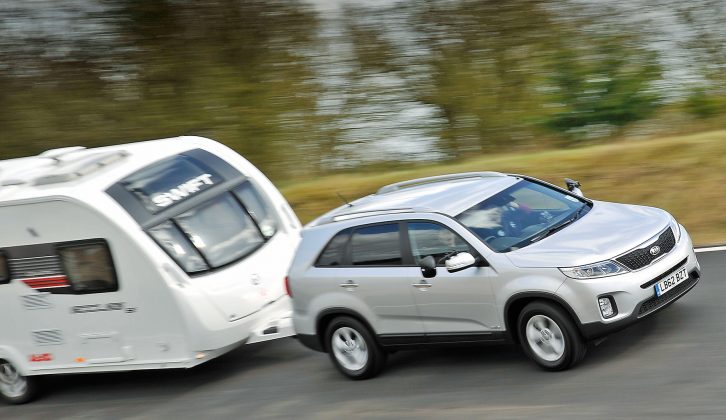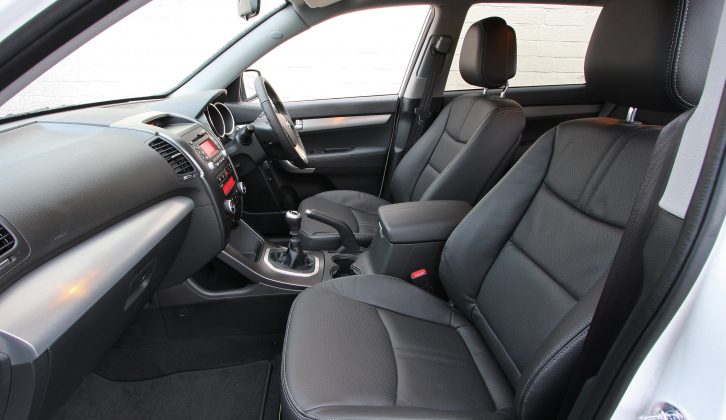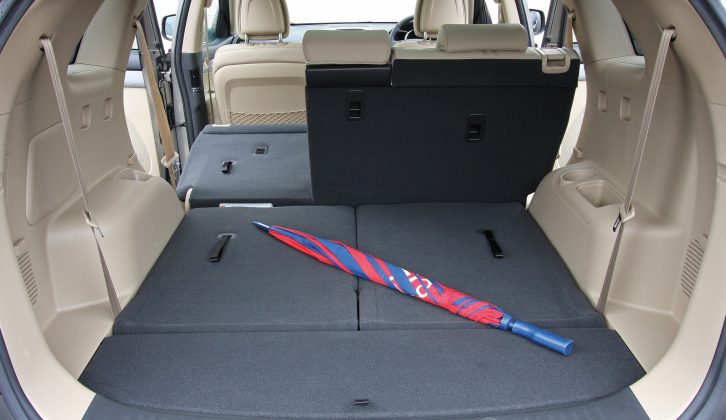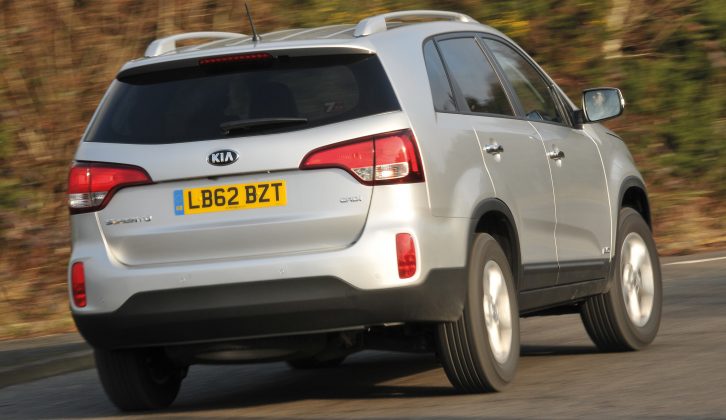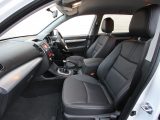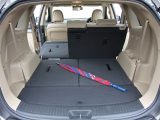Used Kia Sorento 4×4 2010 — 2015 review
Although not intended to be as rough and ready as the original Kia Sorento, this second-generation model can still cut it off-road, and is often used for towing. Be aware that both activities will increase the rate of wear and tear, though, so look out for telltale signs such as scuff marks on the sills and bumpers, or potentially even signs of mud and dirt on the underside of the car or in the wheel arches.
Also ensure that the clutch doesn’t slip or smell on cars with a manual gearbox, because the dual-mass flywheel can be expensive to repair. Or, to put another way, if you want to use your Kia Sorento for towing, it’s worth buying one with an automatic gearbox.
What Car? has a buying service
The underbody spare wheels are, however, vulnerable to theft and cost around £600 to replace. Many owners therefore install a secondary locking mechanism for about £130.
Just two recalls were carried out, early in the car’s life. The first was for a fix to the mood lighting on KX-3 models built up until July 2010, which presented a fire risk due to overheating, and the second was for potential corrosion in the contacts for the rear brake lights, which can prevent them from illuminating. This covers models built up until April 2011. Check that all relevant recalls have been carried out on the car you’re thinking of buying.
Is a used Kia Sorento 4×4 reliable?
Fundamentally, the second-generation Sorento is a reliable car, and Kia as a manufacturer has earnt itself an excellent reputation for the durability of its products. This is reflected in the Korean manufacturer’s third place finish out of 24 manufacturers in the 2016 JD Power UK Vehicle Dependability survey, and means that unless the Sorento you’re looking at has led a particularly hard life to date you’re unlikely to experience any significant problems.
Used Kia Sorento buyer’s guide
Find out what tow car ability the second-gen Kia Sorento has and what it offers as a used prospect
Opt for a Kia Sorento with KX-2 trim and you’ll enjoy the luxury of leather upholstery
You’ll get a decent amount of space for your touring kit, plus the second-generation model has a higher-quality interior
The vast majority of Kia Sorento IIs for sale in the UK have the 2.2 CRDi engine with 194bhp and 311lb ft torque
A heavyweight 4×4 in the BMW X5/Toyota Land Cruiser class and a whole lot cheaper than either, the original Kia Sorento was praised for its towing ability and value when we reviewed it five years ago. Gutsy and cheap, it was the darling of caravanners.
So much was expected of the Sorento II, especially because Kia made a lot of noise about its ethos of constant improvement, and its offer of a seven-year/100,000-mile transferable warranty. That covers everything except brakes, clutch, tyres and other consumables, and makes any secondhand Sorento II with fewer than six figures on the clock an attractive proposition.
The updated version was a little longer and a little slimmer than its predecessor (which is unusual these days) and improved its offer in almost all departments: new, more fuel-efficient engines, better gearboxes, vastly improved looks and a more-sophisticated and higher-quality interior. All but the rarely seen entry-level model got seven seats as standard, and it earned a five-star Euro NCAP safety rating. Does all of that make it a better tow car than the old Sorento?
Model history
Launched in the UK in February 2010, the second-generation Kia Sorento was in theory offered with a choice of three engines: two diesels and a petrol. However, the petrol and one of the diesels were only listed for the base-model two-wheel-drive version.
Few of those were sold at all and, in the case of the 2.4-litre 172bhp petrol, we couldn’t find one for sale, making it a near-mythical beast. Only slightly less mythical is the 2.0 CRDi diesel, which numbered precisely one example on the market. So I think we can dismiss those as curiosities and focus on the only realistic choice: the 2.2 CRDi engine that pumps out 194bhp and 311lb ft of torque.
The vast majority have four-wheel drive and come with manual or automatic six-speed gearboxes. The latter was favoured by around two-thirds of buyers when new, so it is easier to find, though automatic Sorentos were downrated to a 2000kg towing limit – well below the manual car’s 2500kg.
The trim levels are easy to understand: base level is ‘1’, which is only available with two-wheel drive. Even this has air conditioning, 17in alloys, heated mirrors and roof rails. KX-1 is virtually the same but with four-wheel drive. Move up to KX-2 and you add leather seats, cruise control, dual-zone climate control and rear parking sensors. KX-3 provides 18in alloys, rain-sensing wipers, a panoramic sunroof, Xenon headlamps and lots of other toys.
A facelift in mid-2012 dropped the two-wheel drive option and gave all trim levels even more generous ranges of fittings. Suspension revisions improved ride, handling and stability; body revisions cut aerodynamic drag, which cut fuel consumption.
Trouble spots
The general opinion of caravanners we’ve read is that the manual car’s higher 2500kg towing limit should be taken with a large pinch of salt. In fact, the incidence of slipping/burning clutches when starting off on any kind of gradient or reversing makes 1700-1800kg a more realistic real-world towing limit. On the other hand, the automatic gearbox seems more than capable of handling the 2000kg limit, so it’s probably an altogether better bet.
If you don’t fancy a self-shifter or tow a lighter tourer, you should buy a manual car with care – particularly if it has done towing duty. Try accelerating hard from low revs in all gears to check for clutch slip, and feel for clonks from the transmission when changing gear that may indicate wear in an over-stressed dual-mass flywheel – a large added cost on top of clutch replacement.
On Sorentos fitted with cruise control, find somewhere during your test drive to see whether it works correctly, because the system has had issues. If cruise control is something you’re not bothered about, its malfunction can be a handy bargaining tool.
Weighing close-on two tonnes, the Sorento can be hard on tyres, so see how much life is left on what’s fitted and negotiate accordingly – you’re looking at over £100 a pop for anything of decent quality, even with a discount. While we’re on the subject of tyres, ensure that the underslung spare is still there, because they are vulnerable to the light-fingered.
Verdict
The Kia Sorento II is still a class act that sells for a lot less than its badge-laden rivals. It isn’t as good a load-lugger as its much-loved predecessor. It’s not far off, mind you, and great strides have been made in its reliability and in creating a pleasant place to pass the miles. It’s still a bit hard-riding, though, and we’d steer clear of manual gearboxes. Nevertheless, you’ll struggle to find many better three-to-five-year-old, chunky 4x4s for this kind of money.
We think the Kia Sorento KX-2 2.2 CRDi auto is the pick of the bunch. Yes, the KX-3 has a lot more goodies, but we’re not convinced it is worth the extra £1250-£1500. The KX-2 looks better value.
However, we’d steer clear of the Sorento 1 2.2 CRDi because if you’re going to have a car like this, it may as well be a 4×4 – even if it works like a front-wheel-drive most of the time. At least it’s there when you need it.
What you need to know
Today, second-gen Sorentos can cost anywhere between £7500 and £20,000. We did actually see a Sorento II advertised privately for £3950, but it was a KX-1 manual with nearly 200,000 on the clock; £7500, as shown above, is more realistic. KX-2s with some breathing space before they hit the all-important 100,000-mile mark start at around £10,000 for a 2010 model (that’s £15,000 in depreciation in six years) and move up from there. You can pay a little less for a KX-1, and at least £1250 more for a KX-3. Given the warranty issue and the fact that age affects values more than mileage, the hot ticket has to be a 2011 car with low mileage.
Here are some useful figures (for a 2011 Sorento 2.2 CRDi auto):
- Kerbweight 1920kg
- 85% match 1632kg
- Towing limit 2000kg
- Towball limit 100kg
If you’ve bought a used Kia Sorento, you’re preparing it for towing and you need to fit a towball, according to quotes from PF Jones, a Witter flange towbar is £116.60 and a Bosal detachable towbar will cost £231.22, fitting extra.
And when it comes to servicing, an interim service should be around £136.69, a full service £215.54 (thanks to Servicing Stop for the quotes – prices may vary according to location).
Used Kia Sorento 2015-2020 review
Once upon a time, the Kia Sorento was the sort of thing you would have sent round to the servant’s entrance, so basic were its intentions, but the last two versions have had a decidedly upmarket air to them. This third generation model in particular was much improved in its driving behaviour and its fit and finish, and the latest all-new 2021 version is so good that it scooped our What Car? Large SUV of the Year award.
The Sorento may well have been the only fully fledged seven-seater with such a handsome warranty, too: Kia offers a seven-year, 100,000-mile warranty from new, with the chance to extend that to the full seven years on any used car up to 20 months old. Combine that with its sharp looks and it’s no wonder that this 2015 to 2020 model proved such a popular car in the UK.
What Car? has a buying service
The engine’s performance is a bit flat at low revs, but the Sorento is in fact faster than contemporary rivals such as the Nissan X-Trail and Land Rover Discovery Sport, and it’s also noticeably more refined. The average claimed economy figure is reasonable, too, for a car of this size and weight, with the base-spec KX-1 model, on its smaller wheels, recording a respectable 49.6mpg. It rides well, too, and its handling is safe if a little uninspiring. It also has four-wheel drive, so buyers might feel that they have that extra edge of security on difficult roads.
Hop inside and the Sorento has a good driving position, with a driver’s seat and a steering wheel with plenty of adjustment. There’s a commanding driving position, in fact, with excellent visibility. Even the entry-level trim comes with a DAB radio, Bluetooth (including audio streaming), voice control, six speakers, a USB socket and Apple CarPlay and Android Auto smartphone mirroring. All this is controlled through a 7.0in touchscreen. Upgrading to KX-2 and above gets you a better system – an 8.0in touchscreen that also has sat-nav. This system is simple to use because the on-screen buttons are large and clear, so are easy to press while driving.
Space-wise, the Sorento doesn’t disappoint. Two tall adults will have plenty of room – there’s lots of head and leg room, and shoulder room is equally generous. Wide-opening doors help make it easy to get into the front seats. The rear part of the Sorento’s interior is almost as roomy as the front. There’s generous head and leg room for two tall adults to be comfortable and even fitting three is perfectly possible, thanks to the Sorento’s broad interior and flat floor. The two third-row seats are decent, too. Sure, children will be more comfortable than grown-ups, but the seats are fine if you need to take a couple of average-height adults on a short trip.

